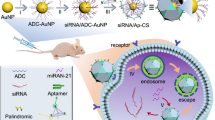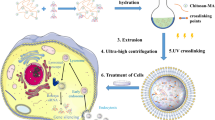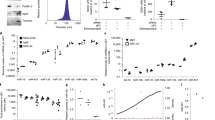Abstract
The encapsulation and delivery of short interfering RNA (siRNA) has been realized using lipid nanoparticles1,2, cationic complexes3,4, inorganic nanoparticles5,6,7,8, RNA nanoparticles9,10 and dendrimers11. Still, the instability of RNA and the relatively ineffectual encapsulation process of siRNA remain critical issues towards the clinical translation of RNA as a therapeutic1,12,13. Here we report the synthesis of a delivery vehicle that combines carrier and cargo: RNA interference (RNAi) polymers that self-assemble into nanoscale pleated sheets of hairpin RNA, which in turn form sponge-like microspheres. The RNAi-microsponges consist entirely of cleavable RNA strands, and are processed by the cell’s RNA machinery to convert the stable hairpin RNA to siRNA only after cellular uptake, thus inherently providing protection for siRNA during delivery and transport to the cytoplasm. More than half a million copies of siRNA can be delivered to a cell with the uptake of a single RNAi-microsponge. The approach could lead to novel therapeutic routes for siRNA delivery.
This is a preview of subscription content, access via your institution
Access options
Subscribe to this journal
Receive 12 print issues and online access
$259.00 per year
only $21.58 per issue
Buy this article
- Purchase on Springer Link
- Instant access to full article PDF
Prices may be subject to local taxes which are calculated during checkout





Similar content being viewed by others
References
Semple, S. C. et al. Rational design of cationic lipids for siRNA delivery. Nature Biotechnol. 28, 172–176 (2010).
Peer, D., Park, E. J., Morishita, Y., Carman, C. V. & Shimaoka, M. Systemic leukocyte-directed siRNA delivery revealing cyclin D1 as an anti-inflammatory target. Science 319, 627–630 (2008).
Mok, H., Lee, S. H., Park, J. W. & Park, T. G. Multimeric small interfering ribonucleic acid for highly efficient sequence-specific gene silencing. Nature Mater. 9, 272–278 (2010).
Liu, L. et al. Self-assembled cationic peptide nanoparticles as an efficient antimicrobial agent. Nature Nanotechnol. 4, 457–463 (2009).
Lee, J. S. et al. Gold, poly(β-amino ester) nanoparticles for small interfering RNA delivery. Nano Lett. 9, 2402–2406 (2009).
Elbakry, A. et al. Layer-by-layer assembled gold nanoparticles for siRNA delivery. Nano Lett. 9, 2059–2064 (2009).
Giljohann, D. A., Seferos, D. S., Prigodich, A. E., Patel, P. C. & Mirkin, C. A. Gene regulation with polyvalent siRNA-nanoparticle conjugates. J. Am. Chem. Soc. 131, 2072–2073 (2009).
Chen, W. et al. Multifunctional magnetoplasmonic nanoparticle assemblies for cancer therapy and diagnostics (theranostics). Macromol. Rapid Commun. 31, 228–236 (2010).
Shu, D., Shu, Y., Haque, F., Abdelmawla, S. & Guo, P. Thermodynamically stable RNA three-way junction for constructing multifunctional nanoparticles for delivery of therapeutics. Nature Nanotechnol. 6, 658–667 (2011).
Guo, S., Tschammer, N., Mohammed, S. & Guo, P. Specific delivery of therapeutic RNAs to cancer cells via the dimerization mechanism of phi29 motor pRNA. Hum. Gene Ther. 16, 1097–109 (2005).
Taratula, O. et al. Surface-engineered targeted PPI dendrimer for efficient intracellular and intratumoral siRNA delivery. J. Control. Release 140, 284–293 (2009).
Grewal, S. I. & Moazed, D. Heterochromatin and epigenetic control of gene expression. Science 301, 798–802 (2003).
Davis, M. E. et al. Evidence of RNAi in humans from systemically administered siRNA via targeted nanoparticles. Nature 464, 1067–1070 (2010).
Akinc, A. et al. A combinatorial library of lipid-like materials for delivery of RNAi therapeutics. Nature Biotechnol. 26, 561–569 (2008).
Seeman, N. C. Nanomaterials based on DNA. Annu. Rev. Biochem. 79, 65–87 (2010).
Chworos, A. et al. Building programmable jigsaw puzzles with RNA. Science 306, 2068–2072 (2004).
Guo, P. The emerging field of RNA nanotechnology. Nature Nanotechnol. 5, 833–842 (2010).
Guo, P. RNA nanotechnology: Engineering, assembly and applications in detection, gene delivery and therapy. J. Nanosci. Nanotechnol. 5, 1964–1982 (2005).
Grabow, W. W. et al. Self-assembling RNA nanorings based on RNAI/II inverse kissing complexes. Nano Lett. 11, 878–887 (2011).
Price, A. D., Zelikin, A. N., Wark, K. L. & Caruso, F. A biomolecular ‘ship-in-a-bottle’: Continuous RNA synthesis within hollow polymer hydrogel assemblies. Adv. Mater. 22, 720–723 (2010).
Afonin, K. A. et al. In vitro assembly of cubic RNA-based scaffolds designed in silico. Nature Nanotechnol. 5, 676–682 (2010).
Khaled, A. et al. Controllable self-assembly of nanoparticles for specific delivery of multiple therapeutic molecules to cancer cells using RNA nanotechnology. Nano Lett. 5, 1797–1808 (2005).
Guo, P. et al. Inter-RNA interaction of phage phi29 pRNA to form a hexameric complex for viral DNA transportation. Mol. Cell 2, 149–155 (1998).
Shu, D. et al. Bottom-up assembly of RNA arrays and superstructures as potential parts in nanotechnology. Nano Lett. 4, 1717–1723 (2004).
Daubendiek, S. L., Ryan, K. & Kool, E. T. Rolling-circle RNA-synthesis—circular oligonucleotides as efficient substrates for T7 RNA-polymerase. J. Am. Chem. Soc. 117, 7818–7819 (1995).
Seyhan, A. A., Vlassov, A. V. & Johnston, B. H. RNA interference from multimeric shRNAs generated by rolling circle transcription. Oligonucleotides 16, 353–363 (2006).
Richards, K. E., Williams, R. C. & Calendar, R. Mode of DNA packing within bacteriophage heads. J. Mol. Biol. 78, 255–259 (1973).
Hendrix, R. W. Bacteriophage DNA packaging: RNA gears in a DNA transport machine. Cell 94, 147–150 (1998).
Trubetskoy, V. S., Loomis, A., Hagstrom, J. E., Budker, V. G. & Wolff, J. A. Layer-by-layer deposition of oppositely charged polyelectrolytes on the surface of condensed DNA particles. Nucleic Acids Res. 27, 3090–3095 (1999).
Banks, W., Thomson, G. & Sharples, A. Formation of spherulites in polyethylene. Nature 194, 542–544 (1962).
Tang, Z. Y., Zhang, Z. L., Wang, Y., Glotzer, S. C. & Kotov, N. A. Self-assembly of CdTe nanocrystals into free-floating sheets. Science 314, 274–278 (2006).
Nakata, M. et al. End-to-end stacking and liquid crystal condensation of 6 to 20 base pair DNA duplexes. Science 318, 1276–1279 (2007).
Tijsterman, M., Ketting, R. F. & Plasterk, R. H. The genetics of RNA silencing. Annu. Rev. Genet. 36, 489–519 (2002).
Decher, G. Fuzzy nanoassemblies: Toward layered polymeric multicomposites. Science 277, 1232–1237 (1997).
Diegelman, A. M. & Kool, E. T. Generation of circular RNAs and trans-cleaving catalytic RNAs by rolling transcription of circular DNA oligonucleotides encoding hairpin ribozymes. Nucleic Acids Res. 26, 3235–3241 (1998).
Acknowledgements
Supported by the National Institutes of Health (NIH) NIBIB Grant R01-EB008082, an American Recovery and Reinvestment (ARRA) grant, the National Science Foundation Grant, Division of Materials Research Polymers Program #0705234 and a Nanotechnology grant from the Koch Institute for Integrative Cancer Research. We also thank the Institute for Soldier Nanotechnologies (ISN) and Center for Materials Science Research (CMSE) for use of facilities.
Author information
Authors and Affiliations
Contributions
J.B.L. and P.T.H. designed the experiments. J.B.L., J.H., D.K.B. and Z.P. carried out experiments. J.B.L., J.H., D.K.B., Z.P. and P.T.H. contributed to analysis of the data. J.B.L. and P.T.H. wrote the manuscript.
Corresponding authors
Ethics declarations
Competing interests
The authors declare no competing financial interests.
Supplementary information
Supplementary Information
Supplementary Information (PDF 2091 kb)
Rights and permissions
About this article
Cite this article
Lee, J., Hong, J., Bonner, D. et al. Self-assembled RNA interference microsponges for efficient siRNA delivery. Nature Mater 11, 316–322 (2012). https://doi.org/10.1038/nmat3253
Received:
Accepted:
Published:
Issue Date:
DOI: https://doi.org/10.1038/nmat3253
This article is cited by
-
Biomembrane-derived nanoplexes for SiRNAs-pioneer innovation in delivery to lung adenocarcinoma
Journal of Nanoparticle Research (2024)
-
Aptamer functionalized nucleic acid nano drug for targeted synergistic therapy for colon cancer
Journal of Nanobiotechnology (2023)
-
Reversible 2′-OH acylation enhances RNA stability
Nature Chemistry (2023)
-
Diversified component incorporated hybrid nanoflowers: A versatile material for biosensing and biomedical applications
Korean Journal of Chemical Engineering (2023)
-
Carrier-free programmed spherical nucleic acid for effective ischemic stroke therapy via self-delivery antisense oligonucleotide
Nano Research (2023)



